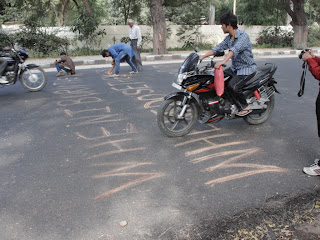Reflections From the tapestry of ‘TANA BANA, Chapter 1, Kota’
15 December 2012
ACROPHILIA: Shweta Purushottam Bhattad and Faith Series
Though a very new face in Indian Art practices, Shweta Purushottam
Bhattad seems to be a focused performer strongly stepping ahead. I met
her on 13th of December 2012, and the very day I saw the presentation of her earlier works at Tana Bana, Kota Chapter.
She is energetic, disciplined, concentrated and ever smiling. Rigorous as a performer, she is a person
who goes through a process of field study before the performance takes place.
Though there is no definition of 'performance art' readily available per say,
some of its aspects could be considered on certain grounds. Shweta’s practices fulfill those
aspects in a very vivid manner. Firstly she uses her body in a very vibrant
manner, knowing how to make the body her subject. Secondly she has
a strong visual vocabulary which many other contemporary performance artists
just overlook in the name of conceptual arts. Oh yes, at the same time she is
very much conceptual. This is exactly why I wish to write on her
performance- that is to speak aloud, that to be conceptual, does not mean being devoid of
visual sensibilities or performative ‘stunts’. Well, here comes ‘stunt’, which
is again a very important part for a performer and performance. Stunt is a word
we mostly use with a negative tone, but in fact stunt or spectacularity
remains an essential element for performance – and Shweta somehow feels that (it
is not the artist’s statement, but what the writer observed).
 |
| extending body, time and engagement... (an earlier performance) |
I haven’t seen previous works of the artist, however I came across some of the documented visuals very recently. The artist seems to have some acrophiliac tendency. In some of her previous works within the 'FAITH SERIES', she hangs or places herself high up and writes the word FAITH. Then recently, I came across a
performance cum digital manipulation work, where also she is hanging on a ceiling
fan.
Why this love for verticality? Or to modify the question, why does a woman artist prefer to place herself above the human eye level? Well, now the entire context will open itself in a different direction. May
be I would prefer to write on this matter later in detail.
 |
| Acrophilia? |
 |
| Acrophilia? |
 |
| Acrophilia? |
It was a dry and a strongly sunlit day. We reached at an area in Kota, where all the institutions that provoke you for higher educational skill, offer a restless commotion with career promises and we saw Shweta sitting on the top of a
building construction crane, writing something on a scroll. She was sitting on
the top of the crane's beam, which was itself a difficult task to do, to maintain
the hydraulic balance constantly, and to keep sitting there above 12-15 feet
from the ground. She was un-winding and scrolling papers from students’ notebooks, and repetitively
writing a word: FAITH. The same monotonous act was happening for a long time.
We were surprised and worried. What if she faints due to the strong sunlight?
The performer was in the air, on top of the crane beam. The
un-rolling papers were falling down and making waves in the air. In the
background on one side, there was some building construction going on, and on the
other side there were coaching-institute buildings, and big hoardings. Just in the opposite
side of the road there was a roadside-bookstore selling coaching class
tutorials. The location, the thematic consideration – both were very much
complimentary.
People from “Hope 24x7 helpline” were distributing their pamphlets to
the people on the street. “Hope 24x7 helpline” is an NGO working for the
consultancy for the depressed students in the coaching institute areas. As Kota
is a place known for the ever-growing coaching institutions, it is also known for
many depression stories and suicides of young talented student. The helpline woks for
the stressed students out there.
The association with the helpline that gives psychiatric solutions
to the stressed students of the coaching classes and tries to prevent
extremities like suicide, and the written word 'FAITH' on the coaching
class notes from the top of a crane that makes building constructions -
contains a very critical insight within itself. On one hand it addresses the
social norms where people are just running after the money making strategies, putting the young students in the rat race of making them engineers or doctors and on
the other hand it addresses the methods of parenting the child.
After seeing the artist’s presentation of earlier works and after
witnessing this particular work at site, I was convinced of the quality of this artist's tendency to engage with ‘on-site-issues’.
The activity happened under TANA-BANA, The Warp and Weft of Art and the Public Domain.
A Public Art Event, 10th-16th Dec, 2012, Kota, Rajasthan
A Public Art Event, 10th-16th Dec, 2012, Kota, Rajasthan















































